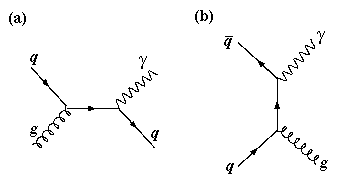 90%) and annihilation graph (
90%) and annihilation graph ( 10%)
shown in Figure 2.
Thus, the cross section is quite sensitive to the gluon distribution in the
proton.
10%)
shown in Figure 2.
Thus, the cross section is quite sensitive to the gluon distribution in the
proton.



One of the promising methods to probe the gluon helicity distribution
is the asymmetry measurement for prompt photon production with high transverse
momentum.
In pp collisions, the production is dominated by the
gluon Compton graph ( 90%) and annihilation graph (
90%) and annihilation graph ( 10%)
shown in Figure 2.
Thus, the cross section is quite sensitive to the gluon distribution in the
proton.
10%)
shown in Figure 2.
Thus, the cross section is quite sensitive to the gluon distribution in the
proton.

Figure 2: Dominant contributions to high- prompt photon production
in pp
collisions, (a) gluon Compton and (b) annihilation processes.
prompt photon production
in pp
collisions, (a) gluon Compton and (b) annihilation processes.
If the polarization of anti-quark is small
(this can be checked in our measurement as discussed in the next section),
the asymmetry is also
dominated by the gluon Compton, and allows simple representation of
the longitudinal spin asymmetry

where  ,
,  represents the partonic asymmetry
for gluon Compton process [8].
By using the knowledge on the quark helicity
distributions, the gluon helicity distribution will
be extracted from the measured asymmetries.
represents the partonic asymmetry
for gluon Compton process [8].
By using the knowledge on the quark helicity
distributions, the gluon helicity distribution will
be extracted from the measured asymmetries.
The yield of the prompt photon production has been estimated with
PYTHIA [9],
one of the widely used QCD event generators and summarized in
Table 2 and Table 3.
Assuming that overall contribution of
 is about 0.2,
the sensitivity of the measurement of the
gluon helicity distribution has been
evaluated and also listed in the tables.
A typical error of the measurement will
be 3-20% at 0.1<x<0.3 in pp collisions at
is about 0.2,
the sensitivity of the measurement of the
gluon helicity distribution has been
evaluated and also listed in the tables.
A typical error of the measurement will
be 3-20% at 0.1<x<0.3 in pp collisions at  GeV, and
1-5% at 0.05<x<0.1 in pp collisions at
GeV, and
1-5% at 0.05<x<0.1 in pp collisions at  GeV.
GeV.

Table 2: Expected yield for prompt photon production at
 =200 GeV and expected
sensitivities for gluon helicity distribution.
=200 GeV and expected
sensitivities for gluon helicity distribution.

Table 3: Expected yield for prompt photon production at
 =500 GeV and expected
sensitivities for gluon helicity distribution.
=500 GeV and expected
sensitivities for gluon helicity distribution.


